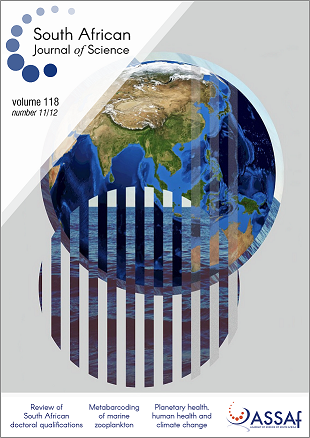Lifting back the waters: Marine geophysics provides new insights into the uThukela Banks Marine Protected Area
DOI:
https://doi.org/10.17159/sajs.2022/14020Keywords:
multibeam bathymetry, seismic reflections, Marine Protected Area, benthic habitatAbstract
Using the first high-resolution geophysical data set collected from the uThukela Banks Marine Protected Area (MPA), we reveal a plethora of hitherto unknown or poorly resolved seabed features. In tandem with several remotely operated vehicle dives, we improve on the previous National Biodiversity Assessment map for the area and reveal a more complex picture of the seabed geology and geomorphology on which the MPA is predicated. The upper slope (-120 m and deeper) is dominated by small canyons, gullies and rills that occasionally extend to the shelf edge and form a series of slumps. Suspected cold-water corals were imaged on the interfluves of the Thukela Canyon. The mid to outer shelf (-60 to -100 m) is mostly rocky, and is composed of Pliocene-age siltstones for the most part. Aeolianite shorelines are found at depths of 60 m and 100 m, in which palaeo-lagoons and parabolic aeolian dune systems are also preserved. These features provide habitat for mesophotic corals and demersal fishes. Overlying and abutting hard rock substrates are unconsolidated sandy sediments that are mobilised by the inshore movement of the Agulhas Current. An inshore mud belt characterised by pockmarks associated with free gas expulsion is mapped for the first time. A well-developed palaeo-drainage pattern is also revealed, posing exciting new opportunities for the study of benthic communities associated with palaeo-estuaries and lagoons now exposed at the seabed. Several new habitats, both inside and out of the MPA boundaries, should form the basis for future research within the MPA, in addition to informing expansions of the MPA.
Significance:
- Using a newly collected geophysical data set, we provide an unprecedented glimpse into the newly proclaimed uThukela Banks Marine Protected Area.
- We reveal a complexity of marine habitats hitherto unknown from previous biodiversity surveys. These habitats include areas of possible expansion given the recognition of keystone species that occur just outside the MPA limits.
Published
Issue
Section
License

All articles are published under a Creative Commons Attribution 4.0 International Licence
Copyright is retained by the authors. Readers are welcome to reproduce, share and adapt the content without permission provided the source is attributed.
Disclaimer: The publisher and editors accept no responsibility for statements made by the authors
How to Cite
- Abstract 654
- PDF 623
- EPUB 446
- XML 297
Funding data
-
National Research Foundation
Grant numbers 97968













.png)